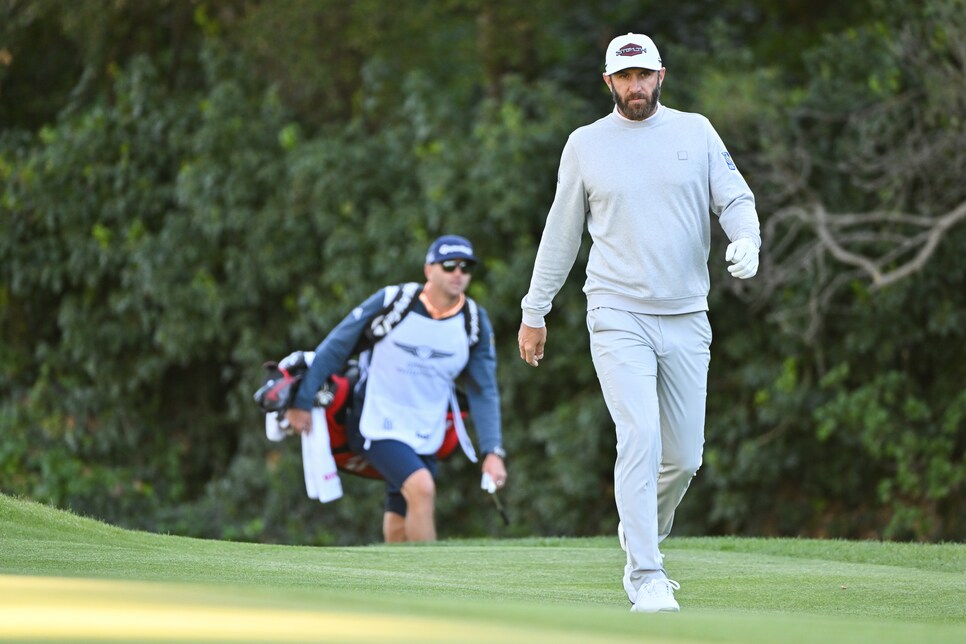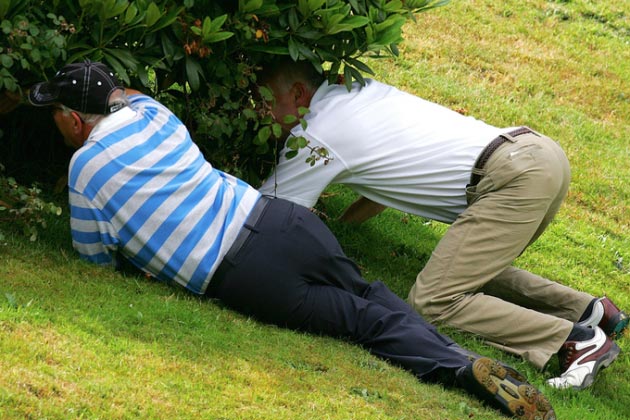Blog
Rahm Ends Remarkable Streak, Spieth’s Wild Ride, & Hovland Turns Heads

Cameron Young broke the 36-hole scoring record for the Genesis Invitational, a pretty big deal considering the annual PGA Tour stop at Riviera dates back nearly a century. There’s just one slightly disappointing part about the 24-year-old’s first two days: He’s not even leading the golf tournament.
That’s because 23-year-old Joaquin Niemann broke that record as well, thanks to a second consecutive 63. That gives Niemann a blistering 16-under-par total of 126 through two days—five shots better than the previous 36-hole low at Riviera.
“I think everything is working pretty well,” Niemann told reporters after. “Obviously I’m making a lot of putts right now. I feel I’m starting my ball online with the putter. When you have greens this good when you start your line, I think you’ve got a good chance of making putts, so I think that’s been big this week.”
The young star from Chile said he didn’t get much sleep with an early tee time, but he eagled the first and birdied the second. After making the turn at five under, he bogeyed the famed 10th hole before bouncing back with birdies on four of his final eight holes.
There will be plenty of time to sleep before Niemann and Young have Saturday’s last afternoon tee time; however, nerves could always get in the way. Young, a two-time winner on the Korn Ferry Tour last year, will be looking for his first PGA Tour title. And for Niemann, who won at The Greenbrier in 2019, it seems that way.
“Yeah, it feels forever actually. I think it was two or three years ago. It feels a long time,” Niemann said. “Obviously you play this game to try to win every week and yeah, but you know how hard it is to win here and how competitive they are, how many good players there are here. You have to be patient and just wait for my week.”
At this rate, he might not have to wait much longer. Here’s what else you may have missed from Friday’s second round at Riviera.
Viktor Hovland turns heads
As he did on Thursday, Hovland played the 15th hole by hitting his tee shot down No. 16. And as he did on Thursday, he made par on the difficult par 4. Have a look:
Take two. ? https://t.co/tqnHYsPmF4 pic.twitter.com/pLH6l7p4YJ— PGA TOUR (@PGATOUR) February 18, 2022
After posting a second-round 64 to vault into contention, Hovland explained his eye-opening strategy.
“So I did that at the U.S. Amateur here in 2017,” Hovland said. “Actually, got to give my buddy Zach Bauchou some credit. He was the guy that first mentioned it. Yeah, I did it there and I did it once last year, I believe it was the third day and it was humming downwind. I think I hit a driver and a sand wedge in there. And there’s not too much trouble there I thought. Obviously that bunker on the left side is no good, but at the same time the bunker down 15 on the right is no good either. I don’t know, just fits my eye.”
But what caught the eyes of other people were Hovland’s lightning pants. Check these bad boys out:
Lightning pants for the win. ⚡️ pic.twitter.com/3fTY6pX3dU— PGA TOUR (@PGATOUR) February 18, 2022
“It’s my first time,” Hovland said of wearing the pants. “Maybe I should keep wearing them.”
Hey, when you’re ranked fourth in the entire world, you can wear whatever you want. And he was certainly in better spirits than the World No. 1 following his round …
Jon Rahm’s remarkable streak ends
Well, he was due for a bad round. And it really wasn’t even that bad.
Rahm shot a one-over-par 72 on Friday, his first over-par round on the PGA Tour since Day 1 of the Open Championship. Yep, that’s right. We’re talking about July. As in seven months ago.
Rahm’s streak of shooting rounds of par or better ended at 34, one of the longest in tour history, and the longest since Charles Howell III also had 34 in 2003. The record, as you probably guess, belongs to Tiger Woods, who once went 52 rounds without shooting over par. Crazy.
On the bright side for Rahm, thanks to a clutch seven-foot par putt on 18, he’ll get to play the weekend. Unlike the next guy . . .
Dustin Johnson’s weird week
Although not technically the betting favorite entering this week (that would be Rahm), Johnson was certainly a favorite among fantasy experts, and for good reason. The two-time major champ has a sparkling record at Riviera with 10 top-10s in 14 starts, highlighted by a win and two runner-ups. But he was the most surprising player to miss the cut—especially when you consider how well he played during his Friday back nine.

Ben Jared
Johnson closed with a bogey-free 31, capped by a birdie on his final hole. But it proved to be too little too late. His undoing? A 40 on his front nine, including a double bogey on the par-3 16th. Oh, and a 73 on Thursday that also featured a double bogey on No. 10.
And all of this amid speculation that Johnson could join the Saudi-backed Super Golf League. Although he was able to avoid the media this week, he was unable to overcome a sloppy short game that cost him more than three shots over two rounds.
It’s been a slow start to the season for Johnson, who has only played in three events with a T-25 at Torrey Pines his best result. If he is thinking about leaving the PGA Tour, that can’t be helping his bargaining power.
Jordan Spieth’s (latest) wild ride
One guy who was using his short game to make up strokes on the field was Jordan Spieth. Shocking, we know.
The three-time major champ flashed some magic on the back nine, beginning with this chip-in eagle on No. 11:
Chip-in eagle at 11. ?@JordanSpieth gets to -10 and -5 on the day. pic.twitter.com/iqQwG0guh4— PGA TOUR (@PGATOUR) February 18, 2022
But then he managed four consecutive up-and-down pars on 12-15, three of which only required tap-in putts. And despite only hitting 11 greens in regulation and losing strokes on the greens, including a three-putt on No. 18, Spieth shot 67 and is T-4 heading into the weekend.
In other words, he’s just where he wants to be. Ready to make another Saturday charge—just this time at a place with no dangerous cliffs.
This article originally appeared on Golf Digest.
Blog
Why Your Golf Balls Disappear (and It’s Not the Gophers)

Ah, the vanishing golf ball. A phenomenon as old as the game itself, and one that has baffled, frustrated, and occasionally driven golfers to the brink of madness for centuries. Most theories involve gophers, those furry, subterranean saboteurs with an insatiable appetite for Titleists. Or perhaps a particularly aggressive squirrel, or a flock of unusually organized crows. But I, Ty Webb, have delved deeper into this mystery, and I can assure you, the truth is far more profound, and far more amusing.
Consider, if you will, the golf ball itself. A small, dimpled sphere, designed for one purpose: to be struck with great force and sent hurtling through the air. A life of constant abuse, of being smacked, sliced, and occasionally submerged in murky ponds. Is it any wonder, then, that some of these brave little spheres simply decide they’ve had enough? They yearn for freedom, for a life beyond the confines of the fairway. They dream of rolling unencumbered through fields of wildflowers, or perhaps, for the more adventurous among them, a quiet retirement in the depths of a particularly challenging water hazard.
I’ve seen it happen, you know. A perfectly struck shot, soaring through the air, destined for glory. And then, poof. Gone. Not a trace. No splash, no rustle in the bushes, just an empty space where a golf ball once was. It’s not a gopher, my friends. It’s an escape. A liberation. That golf ball, in its infinite wisdom, has chosen a different path. It has decided that its destiny lies not in the bottom of a cup, but in the boundless expanse of the unknown.

And who are we to judge? We, who are so obsessed with control, with precision, with the rigid rules of the game. Perhaps the golf ball, in its spontaneous disappearance, is teaching us a valuable lesson about letting go. About embracing the unexpected. About the inherent futility of trying to dictate the trajectory of a small, white sphere that clearly has a mind of its own.
So, the next time your golf ball vanishes into thin air, don’t curse the gophers. Don’t blame your swing. Instead, offer a silent salute to that brave little sphere, wherever it may be. For it has achieved what many of us can only dream of: true freedom. And who knows, perhaps one day, it will return, laden with tales of its adventures, ready to impart some profound, dimpled wisdom upon us all.

When JJ Spaun stood over a 64-foot birdie putt on the 72nd hole of the 2025 U.S. Open at Oakmont, few could have predicted what would come next. The ball meandered across the slick green, trickling over every contour, picking up speed at the crest, and then—like it had GPS—dropped center cup. Spaun dropped his putter, raised his arms, and the crowd erupted. With that single stroke, he claimed his first major title in one of the most dramatic finishes in U.S. Open history.
But how does Spaun’s putt stack up against other legendary finishes in the tournament’s storied past? Let’s break down some of the most iconic moments and see where this one lands.
1. Payne Stewart – 1999 U.S. Open at Pinehurst
Perhaps the most iconic putt in U.S. Open history came from Payne Stewart, who nailed a 15-footer for par on the 18th to win by one over Phil Mickelson. The pose—fist pump and outstretched leg—has since been immortalized in a statue at Pinehurst. What made it legendary wasn’t just the putt—it was the context: Stewart’s final major before his tragic death just months later.
Verdict: Iconic and emotional. Spaun’s putt was longer, but Stewart’s was more poetic.
2. Tiger Woods – 2008 U.S. Open at Torrey Pines
Woods drained a 12-foot birdie on the 72nd hole to force a playoff with Rocco Mediate—while basically playing on one leg. That tournament went to sudden death after an 18-hole playoff, and Tiger prevailed. This was peak Tiger drama, pain and all.
Verdict: Spaun’s putt was longer, but Tiger’s win was sheer willpower and mystique.
3. Jack Nicklaus – 1972 U.S. Open at Pebble Beach
With a 1-iron shot that hit the flagstick on 17 and a crucial birdie putt on 18, Jack sealed a dominant win. His precision and timing under pressure showed why he’s the GOAT.
Verdict: Not a putt for the win, but a signature finishing statement from Jack. Spaun’s was more electric in terms of pure putter drama.
4. Ben Hogan – 1950 U.S. Open at Merion
Hogan’s 1-iron into the 18th fairway and the par to force a playoff—just 16 months after a near-fatal car crash—remain legendary. He won the playoff and completed one of golf’s great comeback stories.
Verdict: Larger-than-life comeback. Spaun’s putt had more flair, but Hogan’s win was heroic.
5. JJ Spaun – 2025 U.S. Open at Oakmont
Let’s not underestimate what Spaun accomplished. The pressure was immense. He wasn’t the favorite. And on the most treacherous greens in golf, he buried a 64-foot bomb—a putt most players would be happy to lag to within 5 feet—to win the U.S. Open outright.
Verdict: For distance, surprise, and drama, Spaun’s putt may be the most shocking winning stroke in U.S. Open history.
Final Thoughts
JJ Spaun may not have the résumé of a Nicklaus or Woods, but for one Sunday afternoon in June 2025, he created a moment that will live in golf lore forever. Spaun’s putt was longer than Stewart’s, more unexpected than Tiger’s, and more dramatic than any final-hole finish in recent memory.
In terms of pure clutch putting? It might just be the greatest walk-off in U.S. Open history.
Blog
The Zen of the Shank: Finding Inner Peace in Your Worst Shots
Find your inner peace even when you aren’t playing well.

Ah, the shank. That glorious, unpredictable misfire that sends your pristine golf ball screaming sideways, often directly into the unsuspecting shins of your playing partner, or perhaps, with a touch of poetic irony, into the very lake you’ve been trying to avoid all day. Most golfers, bless their earnest little hearts, view the shank as a catastrophic failure, a blight upon their scorecard, a testament to their inherent lack of coordination. They curse, they throw clubs, they contemplate a career in competitive thumb-wrestling. But not I. No, my friends, for I, Ty Webb, have found enlightenment in the humble shank.
You see, the shank is not a mistake; it’s a revelation. It’s the universe’s way of reminding you that control is an illusion, that perfection is a myth, and that sometimes, the most direct path to your goal is, in fact, a wildly indirect one. Think of it as a philosophical detour, a sudden, unexpected journey into the unknown. One moment, you’re aiming for the green, a paragon of precision and intent. The next, your ball is ricocheting off a tree, narrowly missing a squirrel, and landing, by some divine comedic intervention, closer to the hole than your perfectly struck drive ever would have. Is that not a miracle? Is that not a sign that the golf gods, much like life itself, have a wicked sense of humor?
The key, my dear apprentices of the links, is acceptance. Embrace the shank. Welcome it with open arms, like a long-lost, slightly inebriated relative. When that familiar, sickening thwack echoes through the air, do not despair. Instead, take a deep breath. Close your eyes. Feel the gentle breeze on your face. And then, with a knowing smile, open them and observe the chaos you have wrought. Is it not beautiful in its own chaotic way? Is there not a certain freedom in relinquishing control, in allowing the ball to choose its own destiny, however bizarre that destiny may be?
Some say the shank is a sign of poor technique. I say it’s a sign of a vibrant, untamed spirit. A golfer who never shanks is a golfer who has never truly lived, never truly explored the outer limits of their own golfing absurdity. They are content with mediocrity, with predictable trajectories and mundane outcomes. But you, my enlightened few, you understand that the true joy of golf lies not in the score, but in the story. And what a story a good shank can tell.

So, the next time you feel that familiar tremor of a shank brewing, don’t fight it. Let it flow. Let it be. For in the heart of every shank lies a lesson, a laugh, and perhaps, just perhaps, a path to a lower score you never saw coming. After all, as the great philosopher Basho once said, “A flute with no holes, is not a flute. A donut with no hole, is a Danish.” And a golf game without a shank? Well, that’s just not golf, is it?
-

 Product Review6 years ago
Product Review6 years agoThe Perfect Practice Putting Mat Review by Jason Tenzer
-

 Blog4 years ago
Blog4 years agoLoophole Rule Offers PGA Tour Pros a Mulligan
-

 Blog4 years ago
Blog4 years ago2021 Buyer’s Guide: The Top 10 Value Golf Balls For Distance & Feel
-

 Blog4 years ago
Blog4 years agoGolf Marriage Counselor
-

 Blog6 years ago
Blog6 years ago9 Biggest Chokes Of The Past Decade
-

 Product Review6 years ago
Product Review6 years agoTHE ADJUSTABLE IRONS: WALKING STICKS GOLF CLUBS
-

 Blog4 years ago
Blog4 years agoWhat Your Golf Clubs Say About You
-

 Equipment6 years ago
Equipment6 years agoOHK Sports Interview by Jason Tenzer































